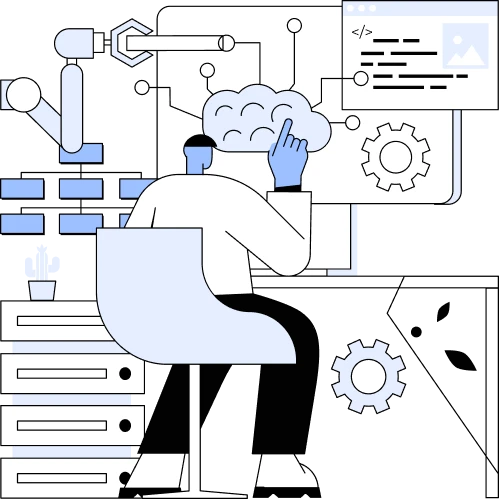Nearly 92% of companies invest in AI, but only 1% of leaders and CEOs consider themselves mature in deploying AI in their operations. This is a huge gap—who is responsible? Leaders and CEOs still treat AI as an experimental project.
For years, 92% of businesses that are using AI have always associated the adoption of AI with job cuts, but 1% of AI Achievers are proving otherwise. Instead of replacing human intelligence with AI, they are continuously leveraging their tech acumen to refine the AI efficiencies and capabilities to streamline their operations.
Data that tell what AI achievers gained on mastering their craft (Accenture):
- 46% of mature AI achievers (CEOs) mentioned AI on their earning calls.
- 42% of achievers said that the return on their AI initiatives exceeded their expectations.
- 40% growth achievement in their share prices.
Will AI transformation happen much faster than digital transformation?
AI transformation is much faster than digital transformation in Growth and revenue. Let’s explore:
Growth:
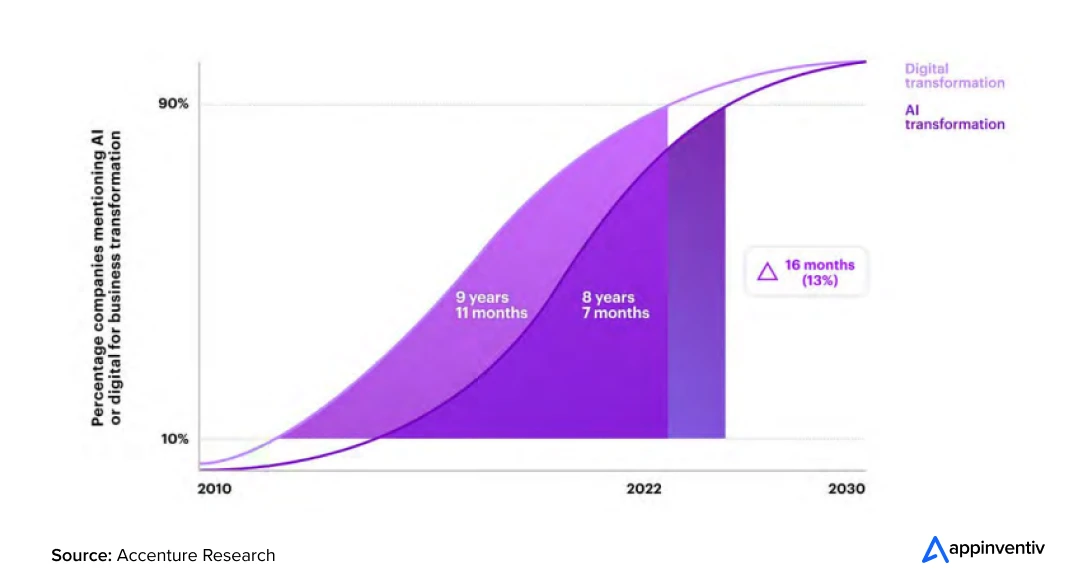
According to Accenture, businesses claimed that AI had accelerated growth faster than digital transformation—on average, 16 months faster.
Revenue:
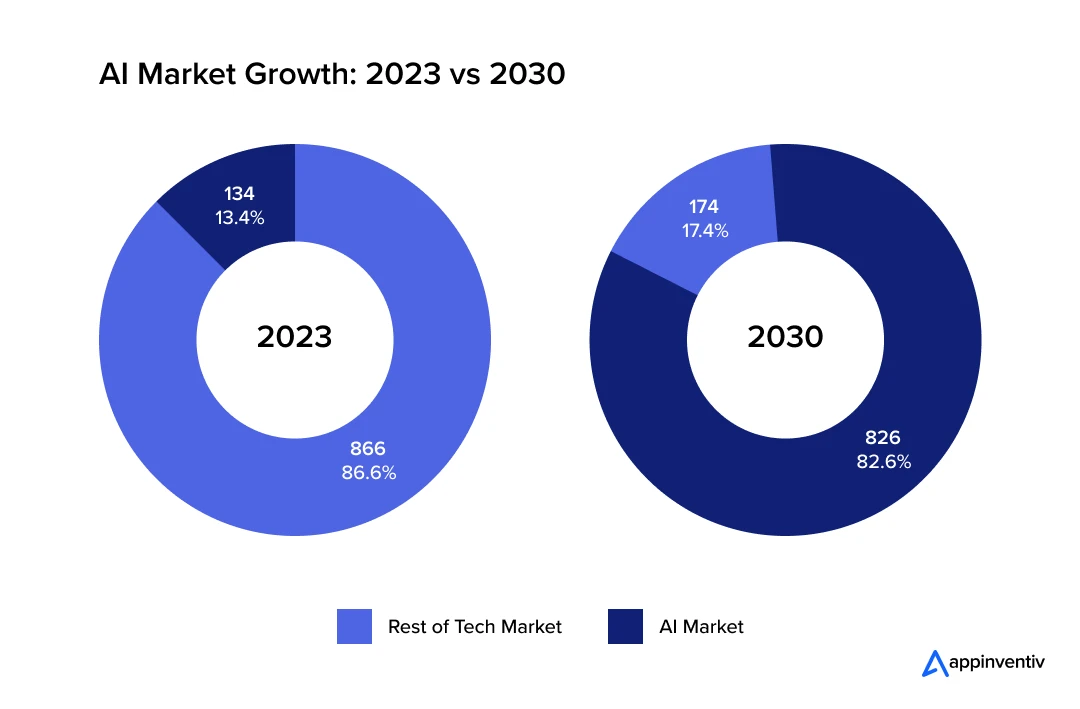
The market for artificial intelligence grew beyond 184 billion U.S. dollars in 2024, a considerable jump of nearly 50 billion compared to 2023. This staggering growth is expected to continue, with the market racing past 826 billion U.S. dollars in 2030.
What do CEOs & AI Leaders do differently to Achieve AI Maturity?
When differentiating the approaches to deploying AI, there is a line of difference between AI experimenters and AI leaders: the ability to combine the strengths of human intelligence and strategies with AI integrations’ capabilities across potential business areas. Below are the five differentiators that make AI leaders stand apart in the AI realm.
1. AI as a Key Strategy: Top brass pushes AI to be at the heart of company plans.
2. Bringing in AI Experts: Big money goes into getting and growing the best AI minds to boost returns.
3. Setting Up a Solid AI Base: AI tools and teams are scaled up to create a strong AI groundwork.
4. Ethical AI Growth: AI is crafted with moral thinking and duty in mind from the start.
5. Smart AI Spending: Money put into AI aims for quick wins and future growth.
Are you an AI innovator aiming to become a true AI leader?
Good news—you’re in the right place. This blog dives into real-world AI integration examples and unpacks that industry giants like Amazon, JPMorgan, and BMW leverage core AI integration strategy to scale their operations while driving business growth. It’s not too late to get ahead—let’s break it down.
Real-World Examples of AI Integration: From the Industry Giants
The success of AI adoption is defined by the degree of AI maturity and how businesses are using AI in their workflow. This section jots down a few AI integration examples. It shows how industry giants like Amazon, Siemens, and BMW embed AI into their workflows to optimize operations, streamline processes, and drive serious business impact. From automation to predictive analytics, see their core AI integration strategy and functionality that make AI work for them—and how you can do the same.
Amazon
Along with an e-commerce giant, Amazon is a cloud computing service provider and tech leader in speech recognition, logistics, and autonomous vehicles. Thus, Amazon uses AI in various potential areas to streamline its operations and enhance its services.
Areas in Which Amazon Integrates AI
Amazon leverages AI across multiple areas, from supply chain management to customer experience, to enhance its operations. Here are a few key areas:
Personalization & Recommendations
- Analyze behavior: Amazon leverages machine learning algorithms for its recommendation system. With this, they analyze user behavior elements like browsing history and past purchases to offer personalized recommendations.
- Filtering Product Suggestions: AI automatically compares customer data with similar users and filters product suggestions based on shared interests.
- Training Models for Future Prediction: With the help of deep learning models, the AI system recognizes patterns in large datasets and predicts future purchases with accuracy over time.
| Result: According to McKinsey, Amazon’s recommendation algorithm drives 35% of its sales. |
Logistics & Supply Chain Optimization
- Demand Forecasting: Amazon leverages the core use-case of Machine Learning in ecommerce smart inventory management. This makes their AI system intelligent enough to analyze past sales, weather conditions, and future marketing trends to predict which products will be in high demand. This assures that the store stocks enough items while avoiding overstocking and reducing waste.
- Delivery Route Optimization: Amazon’s AI system optimizes delivery routes by analyzing weather conditions, traffic patterns, and real-time road closure status to determine the fastest delivery route and ensure delivery reaches customers quickly while optimizing fuel costs.
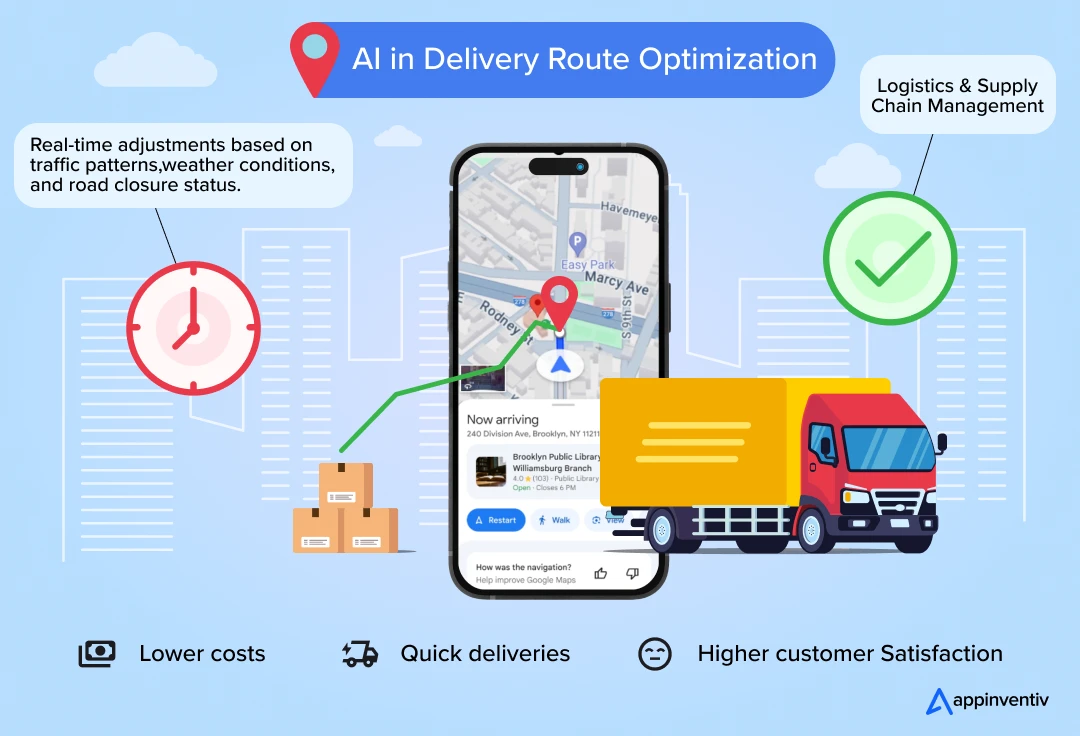
- Warehousing Automation: Amazon deploys AI-powered robots in two sets: the first set of robots will move to the location, search, pick up the products, and pass them on to the packing stations. At the same time, another set of robots will pack orders and ensure they go to the right delivery truck.
Amazon reaps significant benefits from investing in the cost of developing AI agent software. This automation includes enhanced productivity, reduced reliance on excessive labor, and lower operational costs over time.
| Result: According to AWS, AI-optimized pick-and-put-away operations increase labor productivity by 40% |
Amazon Alexa & Voice Recognition
AI integration and Natural Language Processing (NLP) are the leading hands behind Amazon Alexa and voice integration, which understand and respond to user commands. Later, the AI system learns from interactions and personalized commands to enhance the response accuracy and adapt to customized user preferences. These voice assistance technologies make business efficient.
| How AI Works in Amazon Alexa & Voice Recognition | |
|---|---|
| Processes | How Does It Work? |
| Wake Word Detection | AI voice system listens to wake words like: “Alexa there?” and activates upon detection. |
| Speech Recognition (ASR) | AI then converts the spoken words into text, enabling Alexa to understand commands. |
| Natural Language Processing (NLP) | NLP uses transformers to transform and analyze text to determine the intent of speech patterns. |
| Cloud Processing & AI Learning | Alexa transmits data to cloud servers, where AI improves response accuracy and personalizes interactions. |
| Smart Home & Automation | AI makes Alexa smart enough to control smart home devices like lights, thermostats, and security systems via voice or a smart home automation app. |
| Result: According to Yahoo Finance, Amazon has sold over 500 million Alexa-enabled devices and four new Echo products. |
BMW
BMW is among automotive businesses that are using AI to make full self-driving, or autonomous driving, a reality.
Areas in Which BMW Integrating AI
From managing design to production to operations, BMW strives to revolutionize the automotive industry through AI innovations.
AI in Design: From Concept to Personalization
- Generative Design – AI-Powered CAD (Computer-Aided Design): To enhance the functionality, customization, and aesthetics of vehicles, BMW leverages AI-driven software to initiate a computer-aided generative design.
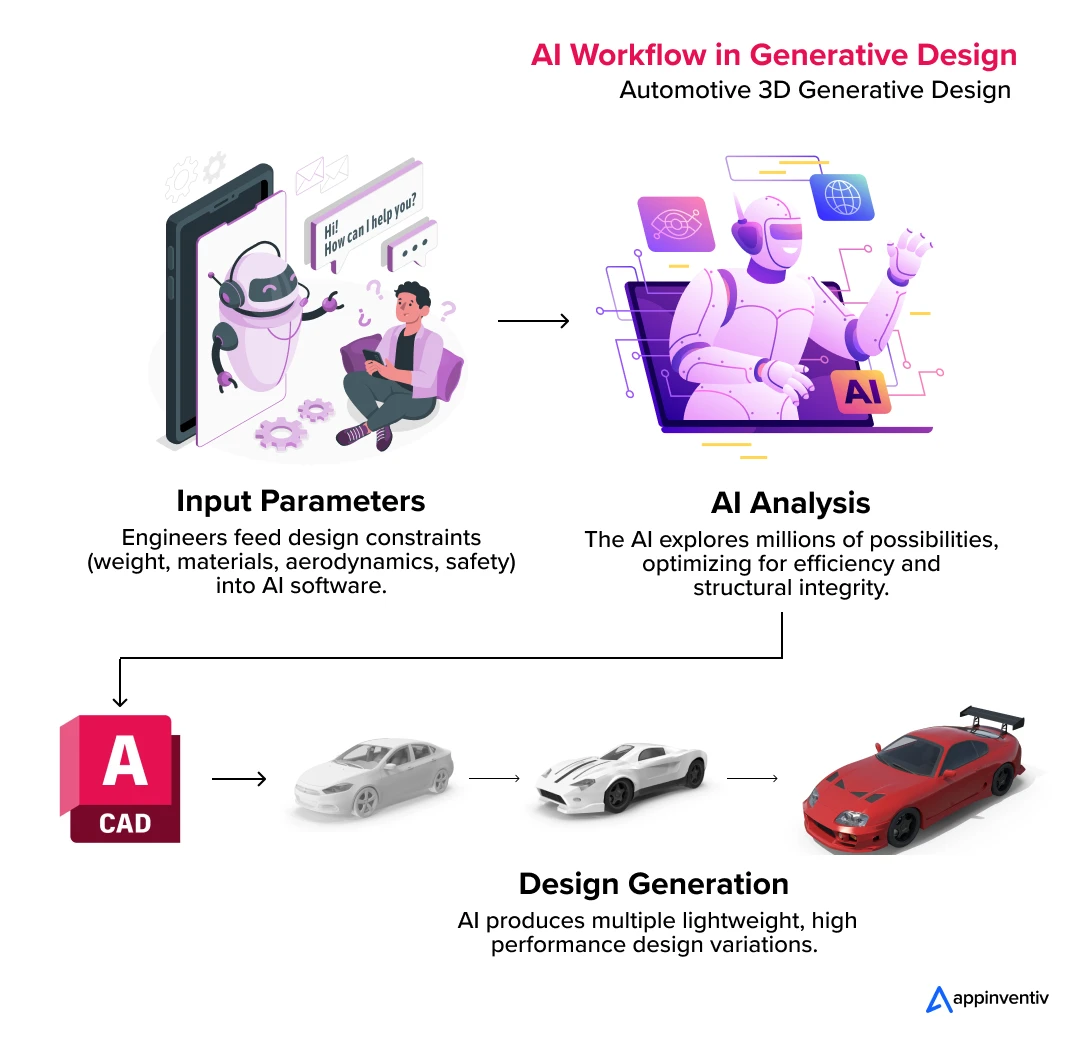
- Prototyping – For AI-Based Simulation & Crash Testing: BMW doesn’t rely solely on physical crash testing. Thanks to AI-based simulation and crash testing, they can predict the behavior of vehicles in various collision scenarios and strategize mitigations accordingly.
| AI’s Role | Process |
|---|---|
| Data Analysis | Analyze datasets from past crash tests. |
| Weakness Prediction | Track and identify structural vulnerabilities |
| Safety Optimization | Enhance safety designs without costly real-world testing. |
AI in Production: Smarter, Leaner Manufacturing
- AI-Driven Quality Control & Defect Detection: BMW leverages an AI-powered computer vision to check manufacturing quality. The technology automation scans car components during assembly to detect potential defects in components like cracks, misalignments, and faulty welds. This helps BMW compare images of and identify inconsistencies to ensure the highest manufacturing standards.
- Predictive Maintenance for Machinery: BMW leverages an AI capability in the form of predictive analytics to pre-plan mitigation strategies for potential failures or operational breakdowns before they occur. AI system analyzes data (monitor vibrations, temperature, and energy usage) from IoT sensors embedded in machinery and keeps check to minimize downtime and reduce maintenance costs.
Bonus Read: 10 Other Uses Cases of Predictive Analytics in Manufacturing
- Supply Chain Optimization: Through AI-driven demand forecasting, BMW enhances supply chain efficiency while reducing challenges and optimizing inventory. AI-powered ERP (Enterprise Resource Planning) systems analyze market trends and production requirements to optimize procurement and reduce material shortage and overstocking.
AI in Operations: Smarter Decision-Making & Customer Experience
- AI in Autonomous Driving: The upshot of AI deployment in BMW operations is the Level 3 autonomous driving technology. AI-powered Advanced Driver Assistance Systems (ADAS) processes real-time road data from cameras, LiDAR, radar, and GPS to make real-time driving decisions.
| AI Functions | Description |
|---|---|
| Object Recognition | Detects pedestrians, vehicles, signs, and road conditions. |
| Decision-Making | Predicts driver behavior and adjusts speed/direction. |
| Real-Time Navigation | Optimizes routes using traffic analysis. |
- AI in Smart Traffic & Parking Management: BMW leverages an AI-powered smart parking system to detect and analyze real-time traffic data to optimize traffic flow and reduce congestion. This helps drivers immediately detect available spots via smart parking apps like RingGo.
| Result: According to Yahoo, BMW’s AI gets a major upgrade with a 400% speed increase as it’s tasked with production line duties. |
JPMorgan Chase
Companies and the fintech industry are on the list of businesses that are using AI to improve their security standards and services.
Areas in Which JPMorgan Chase Integrates AI
Big fintech giants like JPMorgan Chase are leveraging AI in finance to detect fraud detection and enhance security levels while elevating customer services.
- Fraud Detection & Risk Management: JPMorgan Chase leverages machine learning models and NLP to detect fraudulent transactions and activities immediately. AI and NLP analyze emails and chat messages to detect potential compliance violations and immediately flag unusual transaction patterns. For example, if a user suddenly transfers a large sum overseas, AI compares it to their usual behavior and assigns a risk score.
- Loan & Credit Risk Assessment: JPMorgan Chase leverages AI to analyze alternative data, including income, spending patterns, and social behavior, to assess an applicant’s creditworthiness. AI system continuously tracks loan performance to detect early signs of potential defaults before they occur and plan the mitigation strategies accordingly.
- Regulatory Compliance & Reporting: JPMorgan Chase deploys AI to streamline regulatory compliance by scanning and interpreting complex regulations, ensuring organizations stay updated with evolving legal requirements.
| Result: According to a report by JPMorgan Chase, Equipping 80,000 call center employees with AI-powered assistance tools has achieved a 99.9% success rate in operational changes, leading to quicker and more accurate customer responses. |
Johnson & Johnson Healthcare
Leading healthcare providers like Johnson & Johnson are leveraging AI to enhance surgeries, medications, and patient care.
Areas in Which Johnson & Johnson (J&J) Healthcare Integrates AI
Johnson & Johnson (J&J) integrates AI into various areas, including skincare, medical procedures, and drug discovery.
- Data-Driven Skincare (Neutrogena): Johnson & Johnson examines users’ facial features and analyzes skin patterns through an AI-powered app and skin scanner device to recommend personalized skincare routines.
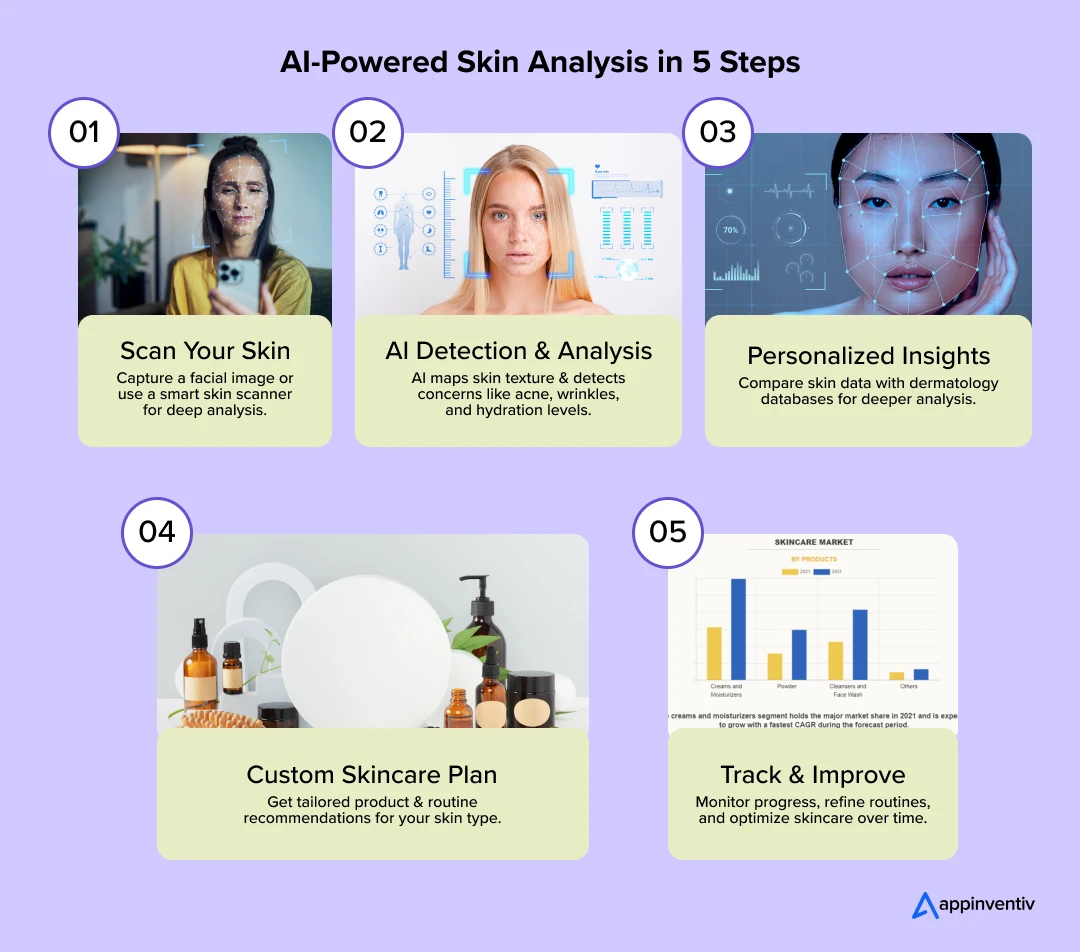
- Simplify Medical Procedures: J&J enhances RPA (Robotic Process Automation) with AI-powered surgical robots to assist doctors in navigating bronchoscopes for lung biopsies, making it easier to locate tumors.
- Drug Discovery & Development: J&J leverages AI models for microscopic compound analysis to understand the structure and predict which compounds could effectively treat diseases.
Bonus Read: The Role of AI in Drug Discovery and Healthcare
Meta Platform
Meta platform is the best example of how social media can use AI to enhance the content and recommendation system.
Areas in Which Meta Integrates AI
- Recommendation system: Meta leverages AI to enhance recommendation algorithms while improving engagement. AI system of Meta analyzes user interactions such as likes, shares, comments, and watch time and understands text, images, and videos through Natural Language Processing (NLP) and Computer Vision. Further, the system finds patterns in user preferences and suggests content based on similar users’ interests.
- AI-Powered Assistant: Meta leverages conversational AI and integrated AI chatbots into WhatsApp and Messenger for businesses. This allows the company to automate customer service and interaction.
| Result: According to Meta, In Q4 2024, they raked in $48.39 billion, a 21% jump from the same quarter in 2023. They hit $164.50 billion for the whole year, up 22%. Their net income for Q4 was $20.84 billion, marking a 49% increase year-over-year. |
Steps to Successful AI Integration & Adoption
As you’ve gone through various AI integration examples, you must understand that AI isn’t just a concept from the future anymore—it’s changing the game for companies that want to improve their productivity, make better choices, and develop new ideas. But bringing AI into a business isn’t as easy as turning on a light switch. You need a well-thought-out plan, the right tools, and, most importantly, steps of AI integration that change how people think and work in your company.
Here are the crucial steps to successful AI integration:
- Set Clear Goals: Figure out what business issues AI will tackle before you start using it. Ensure your AI plans align with your company’s overall aims.
- Check Your Data: AI needs data to work well. Ensure your company has organized good-quality data that’s easy to access for AI models.
- Pick the Right AI Tools: From machine learning to language processing, choose AI options that fit your industry’s needs and can grow with your business.
- Train Your Team: Getting AI to work isn’t just about tech; it’s about people, too. Teach your staff how to work with AI tools and encourage everyone to embrace new tech.
- Use AI: Adopt fair AI practices by dealing with bias, being open about how it works, and following the rules. This helps people trust decisions made by AI.
- Keep Improving: AI systems need regular checks, updates, and tweaks to stay useful in a business world that’s always changing.
Want to dive deeper into the AI adoption and integration process? Know in detail.
Appinventiv’s Pioneering Role in AI Integration
AI expertise can make an enormous difference in your approach to AI integration. Being an AI development company, Appinventiv specializes in developing custom AI services that provide actionable insights and optimize decision-making. Here’s why we stand apart.
Key Benefits from Appinventiv’s AI development services:
- Proven Expertise Across 3000+ Projects: With a proven track record of delivering over 3000 successful projects across diverse sectors, we offer invaluable experience crafting high-quality, customized AI solutions.
- A Talented Workforce of 1600+: In our team of more than 1600 skilled professionals, technical excellence is joined with thorough industry knowledge to create inventive, impactful AI solutions tailored to your business requirements.
- Tailored Business Intelligence Services: At Appinventiv, we focus on your vision, ensuring seamless communication, timely project delivery, and bespoke business AI development services to complement your business goals.
- Award-Winning Innovation and Leadership: Being considered the “Tech Company of the Year” at the Times Business Awards 2023 and winning the Clutch Global Spring Award 2024, we continue to spearhead AI development.
- Proven Client Success: Our client testimonials speak for our success in maintaining excellence for our clients. They appreciate timely delivery, exceptional performance, and a high-quality software solution.
Join Appinventiv today and leverage the power of AI integration to redefine your business operations. Contact us now to turn your AI-powered business vision into a reality!
FAQ’s:
Q. What are the examples of AI integration?
A. There are tons of businesses that are using AI to elevate their business ops while optimizing costs. Some Real-World Examples of AI Integration:
- Ecommerce – Amazon
- Automobile – BMW
- Banking – JPMorgan Chase
- Johnson & Johnson – Healthcare
- Meta Platform – Social Media
Q. What is the impact of AI integration?
A. From boosting efficiency to driving personalized experiences, AI is transforming industries at a rapid pace. Let’s break down the impact of AI integration:
- Process automation
- Business growth & revenue boost
- Smarter decision making
- Increase speed and innovation
- Strengthens Security & Cyber Defense
Q. Why enterprises are adopting AI?
A. AI integration benefits attract enterprises to adopt AI quickly. Some of the noticeable AI integration benefits are as follows:
- AI ensures efficiency and automation that eliminates repetitive tasks
- AI reduces operational costs while increasing productivity and reduces errors
- AI smartly handles massive amounts of data and extracts insights faster
- AI helps deliver hyper-personalized experiences that boost CX
- AI helps enterprises navigate regulations and prevent financial & legal risks
Q. What are the different types of AI integration?
A. Different types of AI integrations depend on industry, process, and business types. Here are the main types of AI integration businesses use:
- Process Automation AI
- Conversational AI
- Predictive Analytics AI
- Business Intelligence AI
- Computer Vision AI
- Risk Management AI
Q. What are AI integration challenges?
A. A few noticeable AI integration challenges are:
- Data Quality & Availability Issues
- High Implementation Costs
- AI Model Explainability & Trust Issues
- Integration with Legacy Systems
- AI Talent Shortage


- In just 2 mins you will get a response
- Your idea is 100% protected by our Non Disclosure Agreement.

How to Integrate AI with EHR/EMR Systems for Streamlined Healthcare Operations
Key takeaways: Not adopting AI in EHR/EMR today risks falling behind. AI streamlines EHR workflows, cutting clinical and admin delays. Real-world hospitals are already seeing faster, smarter care with AI. Seamless AI integration needs system checks, data prep, and training. AI in EHR tackles real challenges like bias, cost, and compliance. Custom AI integration costs…
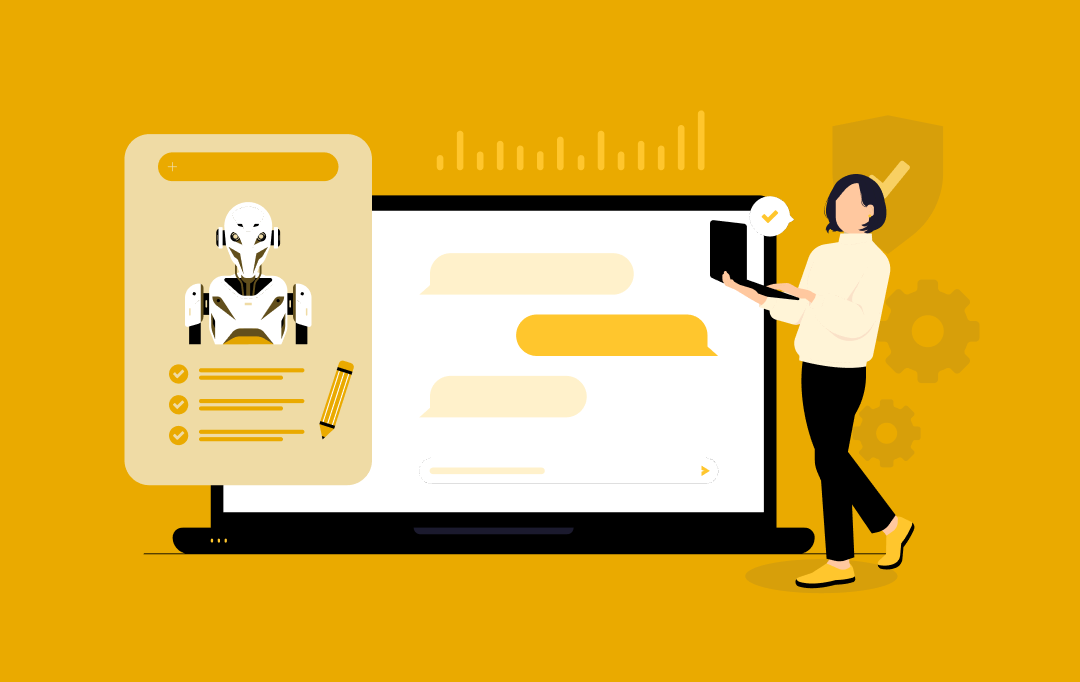
AI Agent-Driven UIs: Replacing App Menus and Buttons
Key takeaways: Challenge: Static menus and buttons also become outdated because people are frustrated by limited, multi-stage navigation. Solution: The AI Agent interacts with the user through a friendly UI that does not require cludgy menus but conversational and context-sensitive navigation. The Way AI Agents Work: AI agents establish a basis of natural language understanding,…
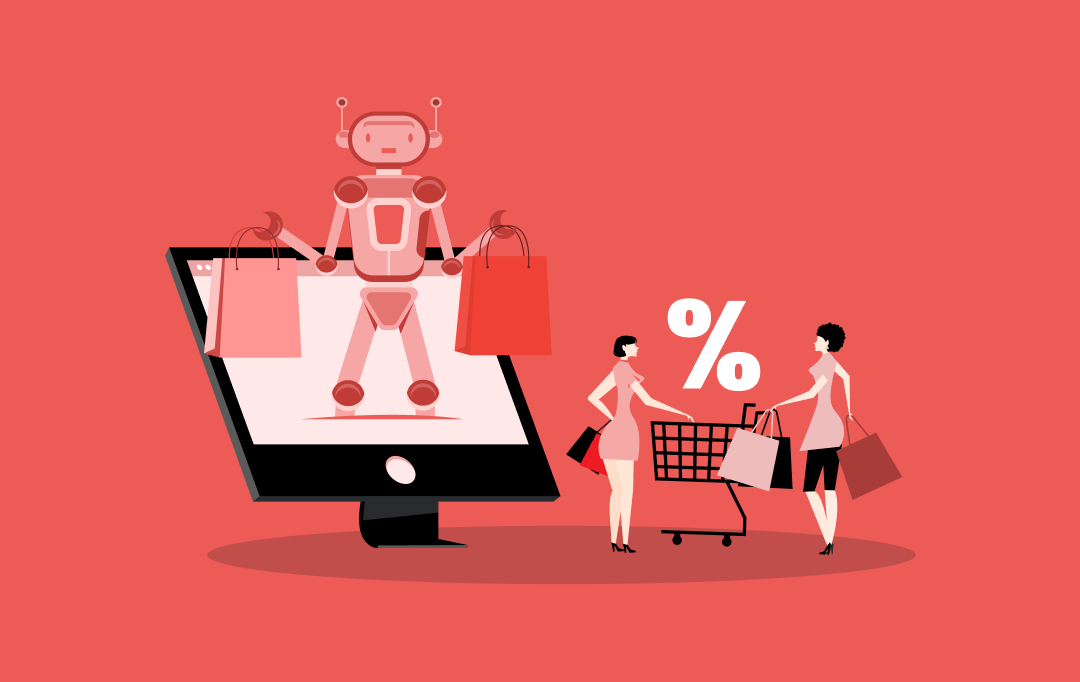
10 Use Cases and Benefits of How AI Agents Are Revolutionizing the Retail Industry
Key takeaways: AI agents in the retail industry are revolutionizing businesses by enhancing customer experience and streamlining operations. From personalized recommendations to predictive analytics, AI offers tangible benefits like increased conversions and reduced costs. AI adoption can lead to scalable growth and a competitive edge in the retail industry. Retailers must consider data strategies, talent…







